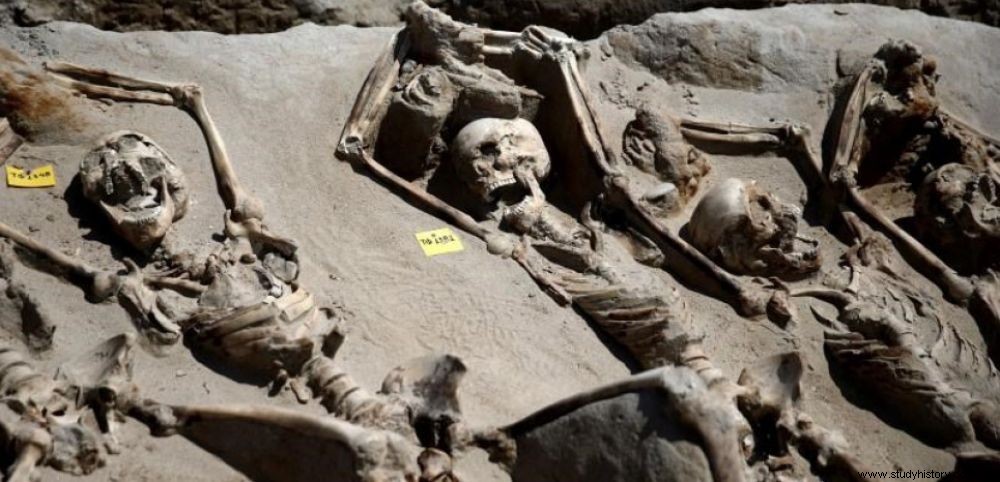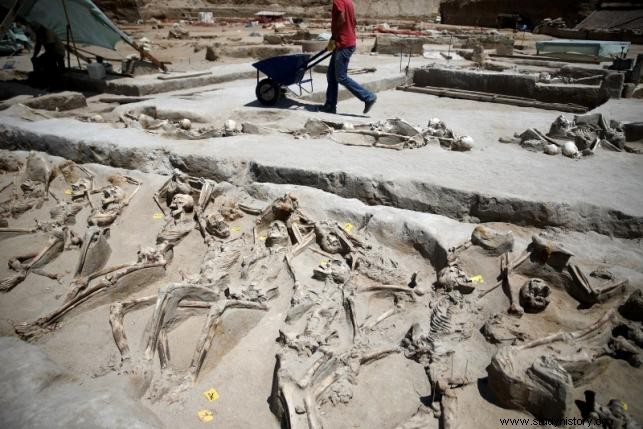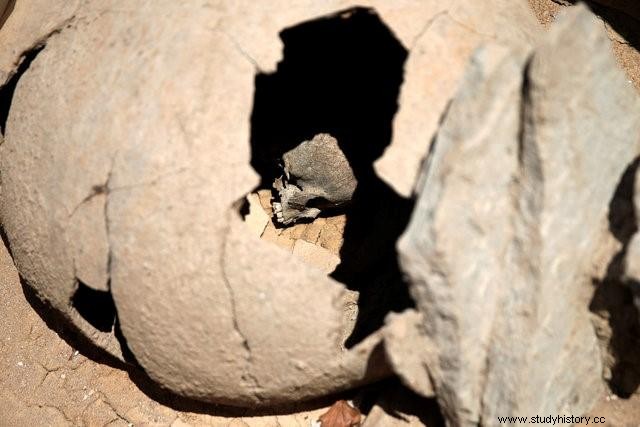 Skeletons with wrists bound in irons unearthed in the ancient Athenian necropolis of Phaleron.
Skeletons with wrists bound in irons unearthed in the ancient Athenian necropolis of Phaleron. PUNISHMENT. Is this a "traitor" cemetery? Gaping jaws, eighty skeletons, some lying side-by-side, were unearthed in a Greek necropolis (VIII th -V e century BC) located in Phaleron (Faliro-Delta), an ancient port between Athens and Piraeus. All had their arms above their heads, tied in irons at the wrists. What evoke a massacre of prisoners. But what could these individuals have done to deserve such punishment? This is the mystery that Stella Chryssoulaki, the archaeologist in charge of the excavations carried out under the direction of the Greek Central Council of Archeology (KAS), is trying to unravel. "Most of these men are very young and were in excellent health at the time of their execution" , the specialist told the press during a site visit on July 27.
Executed after failed coup attempt?
 The ancient necropolis of Phaleron and its mass graves, south of Athens (Greece) © A.Konstantinidis/ Reuters
The ancient necropolis of Phaleron and its mass graves, south of Athens (Greece) © A.Konstantinidis/ Reuters
Excavated last April, these human remains were exhumed from two mass graves during a rescue work undertaken as part of a vast architectural project. The presence of two trefoil pots nearby has made it possible to date the burial period to the 7th century. -VI e century before our era, which corresponds to a moment of great political instability in Attica, the territory of the city-state of Athens. Hence the hypothesis formulated by Stella Chryssoulaki:"It could be Cylon supporters, executed after a failed coup attempt" . If indeed the historians Herodotus and Thucydides are to be believed, Cylon, an aristocrat, former Olympic champion from the ruling class of the Eupatrides, would have tried to seize power in Athens around 632 BC with the support of his father-in-law, the tyrant Theagenes of Megara. Having failed, the conspirators would then have taken refuge in a temple located on the Acropolis, thinking thus to put themselves under the protection of the goddess Athena. Fatal mistake. The conspirators were all said to have been massacred after their rivals promised them their lives.
To try to find out more, the researchers are counting on future DNA analyzes and anthropological examinations which may be able to shed more light on these tragic and enigmatic deaths.
An exceptional necropolis
 Among the many tombs in the Phaleron cemetery are amphoras containing young children. A classic mode of burial in Greek antiquity. © A. Konstantinidis/Reuters
Among the many tombs in the Phaleron cemetery are amphoras containing young children. A classic mode of burial in Greek antiquity. © A. Konstantinidis/Reuters
The Phaleron necropolis, known since the beginning of the XX th century, has really been studied since 2012. To date, the vast cemetery has yielded more than 1,500 graves, mostly made up of pits dug into the sandy soil, as well as remains of cremations. Different types of amphorae containing newborns and infants - so-called "enchytrism" tombs - as was done in Greek antiquity, have also been brought to light. Stella Chryssoulaki would like the place to be laid out so that the inhabitants of the city can discover this exceptional necropolis. Among the ancient Greeks, dying without burial or funeral ritual did not allow one to descend to Hell, the kingdom of the dead. The spirit of the deceased was condemned to wander in Erebus, the darkness, like perhaps the soul of those chained to Phaleron for almost 2500 years.
